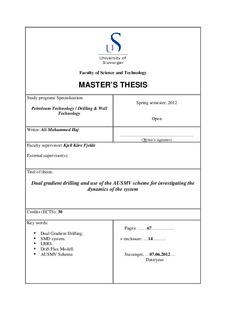Dual gradient drilling and use of the AUSMV scheme for investigating the dynamics of the system
Master thesis
Permanent lenke
http://hdl.handle.net/11250/183456Utgivelsesdato
2012Metadata
Vis full innførselSamlinger
Sammendrag
Offshore drilling is one of the most challenging operations in the oil industry, due to the
complexity of the operation and the harsh work conditions. Some marine prospects are
difficult to drill with the present conventional drilling. Examples of these prospects are the
ultra deep water reservoirs and the depleted offshore reservoirs. The reason is that this type of
reservoirs is characterized by a narrow drilling window due to the small margin between
formation pore and fracture gradients, usually because of the high water column in the first
type and the intensive water injection combined with reduction in reservoir pressure caused
by the production of reservoir fluids. Therefore a need for developing new drilling methods
arose, especially after the recent deep water discoveries in the Golf of Mexico.
Dual gradient drilling (DGD) system started as a joint industry project in 1996, and it has
been developed during the last years. DGD is a new non conventional drilling method, and it
is classified as a managed pressure drilling technique. This drilling method provides a
solution for the drilling issues associated with deepwater and depleted reservoirs drilling.
Most of the drilling issues related to conventional drilling are either minimized or eliminated
by using the DGD. In DGD operations the well hydrostatic pressure is composed of two fluid
gradients, usually seawater (or a low density mud) gradient in the upper part and a heavy mud
in the lower part. Although this new system has many advantages, however there are some
challenges associated with this system. The system has no proven track as the DGD wells are
still few. An additional challenge is the u-tube effect related to mud freefall from the
drillstring during circulation stop. This challenge can be prevented by using the drillstring
valve, but this one need to be developed to achieve the full efficiency. There are different
configurations of DGD system; the most important ones are the Subsea Mudlift Drilling
(SMD), the Low Riser Return System (LRRS) and the Riserless Mud Recovery (RMR)
system.
The AUSMV (Advection Upstream Splitting Method) scheme has been extended to simulate
the dynamics of the SMD system. The AUSMV is a numerical method which is used to
analyse two-phase flow in pipes or wells by providing a solution of the conservation
equations. Two set of simulations was performed. The first simulation was simple and it
aimed to investigate the ability of the AUSMV scheme to handle the SMD system. The results
obtained from the first simulation proved clearly the ability of the AUSMV scheme in
handling the SMD system.
The purpose of the second simulation was to simulate a SMD kick situation. The well
geometry was kept simple, but more realistic data were fed to the AUSMV code. The
proposed well was a 2000 m vertical offshore well with 2000 m water depth, a weighted
drilling fluid was used, and the kick fluid was gas. The most important extensions done with
the AUSMV code were to adjust the boundary conditions to simulate the SMD system. The
simulation began with normal drilling, kick detection and occurrence, kick circulation and
again normal drilling.
The results obtained from this simulation indicated: the ability of early kick detection when
using the SMD, the possibility of controlling the kick situation without using a kill mud since
the same mud density was used before and after kick circulation, and the subsea mudlift pump
used in the SMD system can function as a conventional choke to control well pressures.
Further future simulations can include the use of a more complicated well geometry and using
drilling fluids with different densities in kick simulation.
Beskrivelse
Master's thesis in Petroleum engineering
